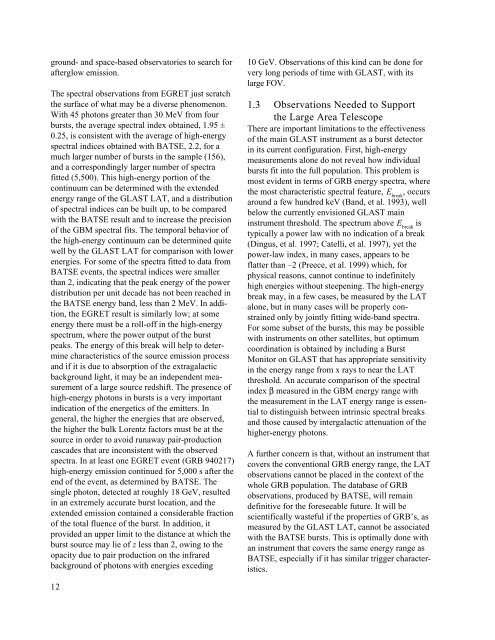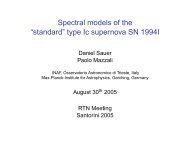Co-Investigator - The Gamma-Ray Astronomy Team - NASA
Co-Investigator - The Gamma-Ray Astronomy Team - NASA
Co-Investigator - The Gamma-Ray Astronomy Team - NASA
- No tags were found...
Create successful ePaper yourself
Turn your PDF publications into a flip-book with our unique Google optimized e-Paper software.
ground- and space-based observatories to search forafterglow emission.<strong>The</strong> spectral observations from EGRET just scratchthe surface of what may be a diverse phenomenon.With 45 photons greater than 30 MeV from fourbursts, the average spectral index obtained, 1.95 ±0.25, is consistent with the average of high-energyspectral indices obtained with BATSE, 2.2, for amuch larger number of bursts in the sample (156),and a correspondingly larger number of spectrafitted (5,500). This high-energy portion of thecontinuum can be determined with the extendedenergy range of the GLAST LAT, and a distributionof spectral indices can be built up, to be comparedwith the BATSE result and to increase the precisionof the GBM spectral fits. <strong>The</strong> temporal behavior ofthe high-energy continuum can be determined quitewell by the GLAST LAT for comparison with lowerenergies. For some of the spectra fitted to data fromBATSE events, the spectral indices were smallerthan 2, indicating that the peak energy of the powerdistribution per unit decade has not been reached inthe BATSE energy band, less than 2 MeV. In addition,the EGRET result is similarly low; at someenergy there must be a roll-off in the high-energyspectrum, where the power output of the burstpeaks. <strong>The</strong> energy of this break will help to determinecharacteristics of the source emission processand if it is due to absorption of the extragalacticbackground light, it may be an independent measurementof a large source redshift. <strong>The</strong> presence ofhigh-energy photons in bursts is a very importantindication of the energetics of the emitters. Ingeneral, the higher the energies that are observed,the higher the bulk Lorentz factors must be at thesource in order to avoid runaway pair-productioncascades that are inconsistent with the observedspectra. In at least one EGRET event (GRB 940217)high-energy emission continued for 5,000 s after theend of the event, as determined by BATSE. <strong>The</strong>single photon, detected at roughly 18 GeV, resultedin an extremely accurate burst location, and theextended emission contained a considerable fractionof the total fluence of the burst. In addition, itprovided an upper limit to the distance at which theburst source may lie of z less than 2, owing to theopacity due to pair production on the infraredbackground of photons with energies exceding10 GeV. Observations of this kind can be done forvery long periods of time with GLAST, with itslarge FOV.1.3 Observations Needed to Supportthe Large Area Telescope<strong>The</strong>re are important limitations to the effectivenessof the main GLAST instrument as a burst detectorin its current configuration. First, high-energymeasurements alone do not reveal how individualbursts fit into the full population. This problem ismost evident in terms of GRB energy spectra, wherethe most characteristic spectral feature, E break, occursaround a few hundred keV (Band, et al. 1993), wellbelow the currently envisioned GLAST maininstrument threshold. <strong>The</strong> spectrum above E breakistypically a power law with no indication of a break(Dingus, et al. 1997; Catelli, et al. 1997), yet thepower-law index, in many cases, appears to beflatter than –2 (Preece, et al. 1999) which, forphysical reasons, cannot continue to indefinitelyhigh energies without steepening. <strong>The</strong> high-energybreak may, in a few cases, be measured by the LATalone, but in many cases will be properly constrainedonly by jointly fitting wide-band spectra.For some subset of the bursts, this may be possiblewith instruments on other satellites, but optimumcoordination is obtained by including a BurstMonitor on GLAST that has appropriate sensitivityin the energy range from x rays to near the LATthreshold. An accurate comparison of the spectralindex measured in the GBM energy range withthe measurement in the LAT energy range is essentialto distinguish between intrinsic spectral breaksand those caused by intergalactic attenuation of thehigher-energy photons.A further concern is that, without an instrument thatcovers the conventional GRB energy range, the LATobservations cannot be placed in the context of thewhole GRB population. <strong>The</strong> database of GRBobservations, produced by BATSE, will remaindefinitive for the foreseeable future. It will bescientifically wasteful if the properties of GRB’s, asmeasured by the GLAST LAT, cannot be associatedwith the BATSE bursts. This is optimally done withan instrument that covers the same energy range asBATSE, especially if it has similar trigger characteristics.12



